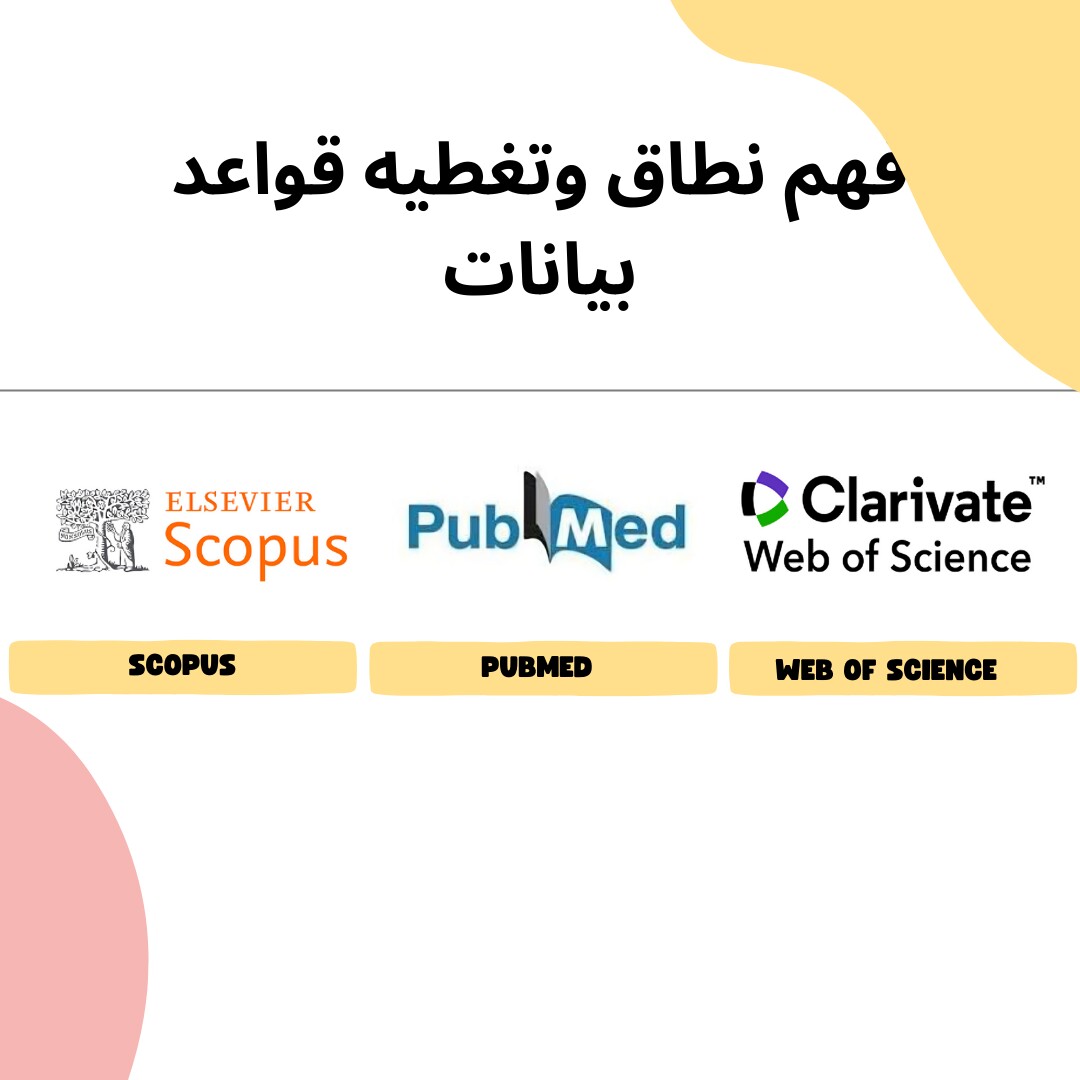فهم نطاق وتغطیه قواعد بیانات Scopus وWeb of Science وPubMed


عندما یتعلق الأمر بقواعد بیانات الأدبیات الأکادیمیه، فإن لکل من Scopus وWeb of Science وPubMed نقاط قوه ومجالات ترکیز فریده. لفهم نطاق وتغطیه هذه المنصات بشکل أفضل، دعونا نقوم بتحلیل مقارن لأنواع المحتوى التی تقوم هذه القواعد بفهرستها.
نوع المحتوى | Scopus | Web of Science | PubMed |
|---|---|---|---|
المجلات | أکثر من 23,000 مجله محکمه من 5,000 ناشر حول العالم | تغطی أکثر من 21,000 مجله، مع ترکیز قوی على المنشورات ذات التأثیر العالی والمفهرسه حسب الاقتباسات | تقوم بفهرسه مجلات فی العلوم الطبیه الحیویه وعلوم الحیاه، مع مجموعه تضم أکثر من 33,000 عنوان |
المؤتمرات | تتضمن وقائع أکثر من 225,000 مؤتمر وفعالیه | تفهرس وقائع مؤتمرات مختاره عالیه الجوده، خاصه فی مجالات العلوم والتکنولوجیا | تغطیه محدوده للمنشورات الخاصه بالمؤتمرات، مع الترکیز على فعالیات العلوم الطبیه الحیویه وعلوم الحیاه |
المطبوعات الأولیه (Preprints) | تدمج محتوى من خوادم المطبوعات الأولیه الشهیره مثل arXiv وbioRxiv وmedRxiv | لا تفهرس حالیًا خوادم المطبوعات الأولیه، مع احتمالیه التغییر مستقبلًا | تفهرس المطبوعات الأولیه من مستودعات العلوم الطبیه الحیویه وعلوم الحیاه مثل bioRxiv وmedRxiv |
کما یوضح هذا الجدول، فإن لکل قاعده بیانات ترکیز ممیز من حیث أنواع المحتوى التی تغطیها. تمیل Scopus وWeb of Science إلى امتلاک نطاق أوسع، حیث تفهرسان مجموعه متنوعه من المجلات المحکمه ووقائع المؤتمرات المختاره، بینما تعد PubMed أکثر تخصصًا فی مجالات الطب الحیوی وعلوم الحیاه.
إلى جانب أنواع المحتوى، فإن الترکیز التخصصی والتمثیل الإقلیمی للمنشورات المفهرسه فی هذه القواعد تعد عوامل أساسیه یجب أخذها بعین الاعتبار.
تغطی مجموعه واسعه من التخصصات، بما فی ذلک العلوم، التکنولوجیا، الطب، العلوم الاجتماعیه، والعلوم الإنسانیه.
ترکز بشکل رئیسی على العلوم، التکنولوجیا، والطب، مع بعض التغطیه للعلوم الاجتماعیه والفنون والعلوم الإنسانیه.
تغطی الأدبیات المتعلقه بالعلوم الطبیه الحیویه وعلوم الحیاه فقط، مع ترکیز قوی على الطب السریری، علم الأحیاء، والمجالات ذات الصله.

تفهرس منشورات من أکثر من 5,000 ناشر حول العالم، مع تمثیل متوازن نسبیًا للمحتوى من أمریکا الشمالیه وأوروبا وآسیا.
تاریخیًا، کانت ترکز بشکل أکبر على المنشورات من أمریکا الشمالیه وأوروبا الغربیه، لکنها وسعت تغطیتها العالمیه فی السنوات الأخیره.
تفهرس بشکل أساسی المجلات باللغه الإنجلیزیه، مع تمثیل کبیر للمنشورات من الولایات المتحده والدول الناطقه بالإنجلیزیه.

تقدم Scopus مجموعه شامله من المقاییس المبنیه على الاقتباسات، بما فی ذلک:
CiteScore
SNIP (Source Normalized Impact per Paper)
SJR (SCImago Journal Rank)
تُقیِّم هذه المقاییس تأثیر المنشورات، المؤلفین، المؤسسات، والمجلات. وتوفر تقییمات دقیقه من خلال أخذ عوامل مثل إمکانیه الاقتباس وهیبه المجله فی الاعتبار. کما توفر Scopus تقاریر تحلیلیه تفصیلیه لأداء الاقتباسات وأنماط البحث والاتجاهات.
تُعرف Web of Science بمؤشر تأثیر المجله (Journal Impact Factor - JIF)، وهو مقیاس معروف على نطاق واسع لتقییم تأثیر الاقتباس للمجلات. کما یتیح مجموعه Web of Science Core Collection تحلیلات قویه للاقتباسات من خلال:
مؤشر h-index
تقاریر الاقتباسات
أدوات رسم خرائط الاقتباس
تتبع هذه الأدوات تأثیر البحث وتصوّر شبکات الاقتباسات.
لا تقدم PubMed مقاییس مباشره مبنیه على الاقتباسات أو أدوات تحلیل متقدمه، لکنها متکامله مع قاعده Web of Science Core Collection، مما یتیح للمستخدمین الاستفاده من میزات تحلیل الاقتباسات الخاصه بـ Web of Science للمنشورات المفهرسه فی PubMed.
هل أنت غیر متأکد من المجله الأنسب لنشر مقالتک القادمه؟
نحن نساعدک على التنقل فی المشهد المعقد للمجلات الأکادیمیه وتحدید الخیارات الأکثر موثوقیه والمتوافقه مع نطاق بحثک. وسنرشدک خلال کل خطوه من خطوات رحله النشر.
یتمتع فریقنا من الباحثین الخبراء بمعرفه عمیقه بقواعد البیانات الرائده مثل Scopus وPubMed وWeb of Science. یمکننا أن نوفر لک قائمه مختاره من المجلات، تتضمن معلومات تفصیلیه لمساعدتک على اتخاذ القرار المناسب:
روابط مواقع المجلات
نطاق وترکیز المجله
رسوم معالجه المقال (APC)
تفاصیل الفهرسه (Scopus، MEDLINE، Web of Science، إلخ)
مؤشرات التأثیر مثل CiteScore وSNIP وSJR وJournal Impact Factor
بمجرد اختیارک لمنصه النشر المثالیه، سنتولى الباقی. سیقوم محررونا ذوو الخبره بتنسیق مخطوطتک وفقًا لمواصفات المجله المستهدفه، ونتولى عملیه التقدیم نیابه عنک. وسنقوم بمتابعه حاله الورقه وتقدیم تحدیثات فی کل مرحله.
إذا کان لدیک أی أسئله، استفسارات، أو ترغب فی معرفه المزید عن خدماتنا، فلا تتردد فی التواصل معنا. فریقنا المخصص مستعد لمساعدتک.